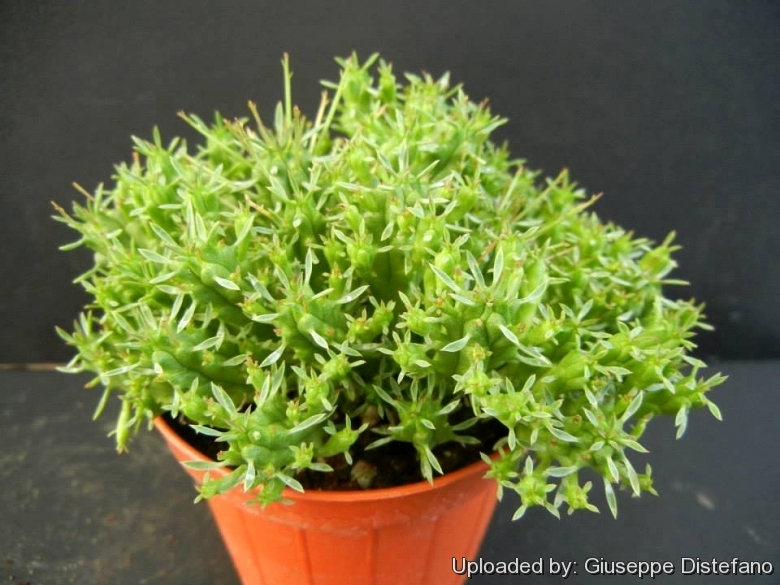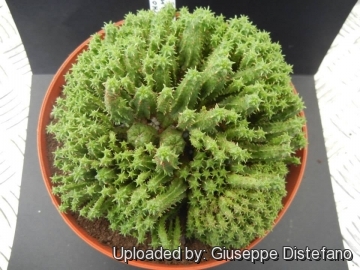Accepted Scientific Name: Euphorbia submamillaris (A.Berger) A.Berger
Sukkul. Euphorb. 95 1907 publ. 1906. A.Berger

Euphorbia submammillaris f. pfersdorfii Photo by: Giuseppe Distefano
Origin and Habitat: It is known only as a cultivar.
Synonyms:
See all synonyms of Euphorbia submamillaris
back
Accepted name in llifle Database:Euphorbia submamillaris (A.Berger) A.BergerSukkul. Euphorb. 95 1907 publ. 1906.Synonymy: 4
back
Common Names include:
ENGLISH: Pickaninny toes, Kaffirtoes, Maternity Ward Euphorbia
RUSSIAN (Русский): Молочай пферсдорфа
Description: Euphorbia submammillaris f. pfersdorfii (Euphorbia pfersdorfiiSN|27728]]SN|27728]]) is a curious and rare plant, showing extreme reduction in stems size. It is supposed by some to be a mutant form of Euphorbia submammillaris or maybe an hybrid. It produces innumerable small, few-angled branchlets and forms compact crowded cushions. It is known only as a cultivars.
Stem (branches): Clavate 2-5(-8) mm in diameter, 5-45 (or more) mm tall, 5-ribbed, with tooth-like tubercles, bright green. As the stems continue to grow, they will become brown and woody looking, except for the green buttons on the top.
Spines: The “spines” are indeed solitary lignified reddish inflorescence stems sterile c. 5-10 mm long long, with 3 - 4 small bracts.
Leaves: Short-lived, lanceolate (about 5 mm long).
Bibliography: Major references and further lectures
1) Alain Campbell White, Robert Allen Dyer, Boyd L. Sloane "The succelent Euphorbisae (southern Africa)" Abbey garden press, 1941.
2) W.G. Tolton “Canadian Florist” Volume 44 1949.
 Euphorbia submammillaris f. pfersdorfii Photo by: Giuseppe Distefano
Euphorbia submammillaris f. pfersdorfii Photo by: Giuseppe DistefanoSend a photo of this plant.The gallery now contains thousands of pictures, however it is possible to do even more. We are, of course, seeking photos of species not yet shown in the gallery but not only that, we are also looking for better pictures than those already present.
Read More... Cultivation and Propagation: It is an easy to grow plant for pot culture.
Growth rate: It is a relatively rapidly growing species that will make large clumps whit hundreds or even thousands heads given the best conditions.
Soil: It grows well in a very draining mineral potting substrate, but it isn't picky about soil.
Repotting: Use pot with good drainage.
Watering: During the summer they enjoy average watering, but do not overwater (Rot prone), keep dry in winter.
Fertilization: Feed with a high potassium fertilizer in summer.
Hardiness: When dormant in winter, keep it totally dry at or around 4°C, even though it seems to tolerate light frosts well.
Exposure: They do need a lot of light to keep their compact growth-form. They get a rich purple tinge if grown in full sun, however some protection in light shade is recommended during the hottest hours in summer.
Uses: It is an excellent plant for container growing. It always looks good and stays small. It looks fine in a cold greenhouse and frame.
Warning: As with all other Euphorbias when a plant get damaged it exudes a thick white milky sap known as latex. This latex is poisonous, and may irritate skin. Pay extreme attention not to get any in your eyes or mouth.
Cultivated plants must be handled carefully.
Rot: Rot it is only a minor problem with Euphorbias if the plants are watered and “aired” correctly. If they are not, fungicides won't help all that much.
Propagation: It is propagated by cuttings (It branches enthusiastically, and offsets are readily available). If you remove an offset, remember to let it dry for some days, letting the wound heal (cuttings planted too soon easily rot before they can grow roots). Lay it on the soil and insert the stem end partially into the substrate. Try to keep the cutting somewhat upright so that the roots are able to grow downward. It is better to wash the cut to remove the latex.











